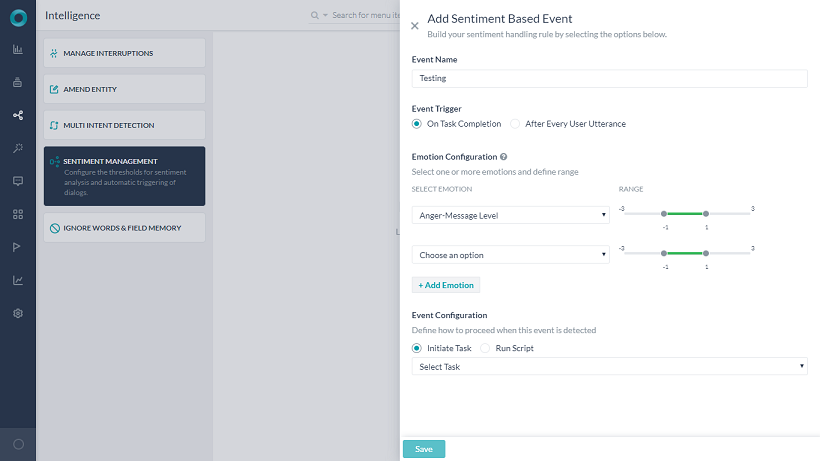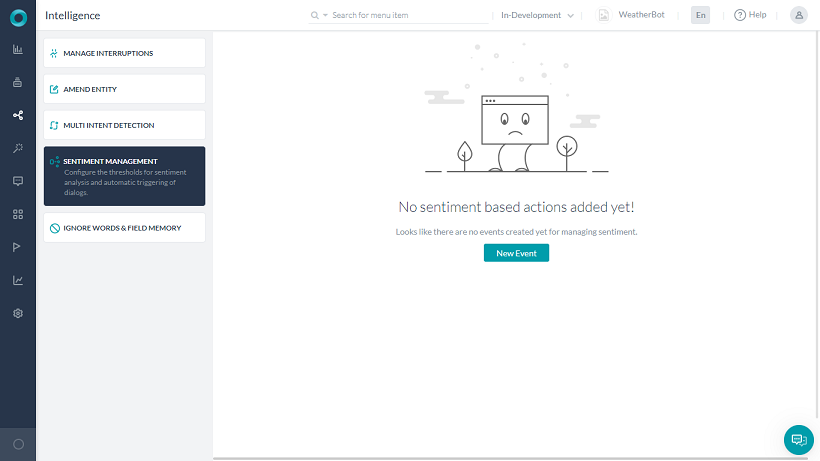Emotion tones are critical indicators in understanding the attitudes and opinions of users interacting with the bots. Sentiment Management allows the developer to define and trigger events based on the user’s emotion or sentiment.
Notes
- This feature was introduced in v7.0.
- This feature is not supported in all languages. Click here for details.
Negative emotion scenarios like anger or disgust are typically considered for transferring the conversation to a live agent.
The Natural Language Processing (NLP) interpreter can parse user utterances for specific words and phrases, and then provide an average tone score based on the connotation, word placement, and any added modifiers. (Click here for more on Tone Analysis)
The tone or sentiment scores are stored as context and used to drive the flow of a dialog task through conditional transition statements. You can use these scores to steer user-bot conversations or seamlessly invoke escalation to a live agent.
Following parameters can be configured for a sentiment event:
- Event Name – Name of the event.
- Event Trigger – Defines how often the sentiment must be checked. It can be set to:
- On Task Completion – Sentiment is checked only after completion of a task (dialog, action, alert, and information task).
- After Every User Message – Sentiment is checked after every message from the end-user. The event is evaluated before proceeding with the conversation using the incoming utterance.
- Emotion Configurations
- Select the required emotions to be captured from a list of six tones, angry, disgust, fear, sad, joy, and positive.
- Select if the tone should be considered at the Session level or Message level
- Session-level tone value is a consolidated tone value across all user messages in a conversation session.
- Message-level tone value is a tone value calculated for a given message from the user.
- Define the range to be considered for each of these tones, the range can be between -3 to +3. (Click here for more on Tone Analysis)
- When multiple emotions are selected, the event is triggered when ALL the tone rules are met. In case you want the event to trigger when any tone rule is met, add them as separate rules.
Post v8.1, the platform can identify the emojis in user utterance and set the tone accordingly. - Event Configuration – The result of the event trigger could be either to Run a Dialog or Run a Script.

Event Flow
Emotion tones are continuously updated whenever a message received from the users and as such the sentiment events are also continuously evaluated. When an event’s criteria are met, the platform triggers the defined behavior.
- If the configuration used is to Initiate a task, then the current task is discarded and the bot switches to the new task according to the event configuration.
- Any other implicitly paused tasks will also be discarded.
- Tasks that are kept on hold using Hold and Resume settings are resumed as per Hold and Resume configuration.
- If the dialog selected to trigger for the sentiment event is not available for any reason, then a standard response is displayed. Refer to the standard response with the title Dialog task required for conversation is not available for more information. (more on standard responses).
- If the configuration used is to Run the script, then the platform executes the script and continues with the task execution. In case of any errors executing the script associated with the sentiment event, then a standard response is displayed. You may refer to the standard response titled Error in continuing the conversation due to incorrect bot definition for more information. (more on standard responses).
- In case of a conflict between a sentiment event and direct intent invocation by the user, sentiment event is given precedence.
- When tone criteria for two or more sentiment events are satisfied at the same instance, then the platform prefers the sentiment event with the highest order of precedence used in defining the events.
Execution Flow for Universal Bots
- Events configured at the universal bot are honored over the events defined in the child bots.
- If an event at the universal bot is qualified, then the corresponding behavior is triggered.
- If an event at the universal bot is not qualified or not defined, then the events defined for the child bot that the user is interacting with are evaluated and triggered if qualified.
- If no child bot is being executed, then child bot events are not evaluated.
Reset Tone
By default, sentiment values are reset at the beginning of every user conversation session.
Apart from the beginning of the conversation session, the platform resets the sentiment values (i.e. tone scores) once the associated events are triggered. The reset behavior is based on the type of event trigger:
- If a script is run, then the values are reset after successful execution of the script.
- In case of a dialog task is triggered, the values are transferred to the new dialog task’s (triggered by the sentiment event) context and reset in the original global context.

